Grades 10-12 Lesson Plan Using the Radical Equality Online Exhibit
Making Ideals Real in History and in the Classroom
Lesson Overview
Students/class will read the goals and objectives for the Northampton Association of Education and Industry (NAEI). Class will discuss why they believed that the founders had these goals and objectives. Students will then design their own utopian communities based on the goals and objectives of the NAEI but in present-day America. They will create a map, description, and constitution for their community. After completing their communities students will research, discuss, and explore the NAEI website to compare and contrast their version with the historical version. Groups will read the NAEIconstitution and analyze it. As a final step students will reflect on the desires for and difficulties of creating change in society and how the NAEI demonstrates these issues.
PREVIOUS KNOWLEDGE RECOMMENDED
Prior to participating in this lesson, students should have basic understanding of the utopian communities that formed during the 1840s. They should have a basic understanding of the Market Revolution and Industrial Revolution and how it had changed American industry in the 1830s and 40s. Lastly, they should be aware of the many reforms that were taking place across the country, many of which were a result of the Second Great Awakening.
Lesson Time
Two class periods–if the lesson is taught in full. Parts of the lesson could be cut down or used separately.
Learning Objectives
This lesson meets many of the MA Curriculum Frameworks Standards.
By the end of the lesson students will…
Know:
- The goals of the Northampton Association of Education and Industry
- The key ideas behind NAEI’s constitution
Understand:
- Why it is difficult to actualize ideals and beliefs.
- Why and how people try to change society.
- Why utopian communities failed.
- How NAEI connects to the larger communitarian movement and the reforms of the 1840s.
Be able to:
- Create their own utopian society with a map, description, and constitution
- Analyze the difficulties of creating change in society
- Evaluate the successes and failures of utopian societies
- Identify the key goals and objectives of the Northampton Association
- Link the Northampton Association to the larger utopian movement
Language Objectives
- Students will read the Northampton Association’s constitution
- Students will write their own constitution for their utopian society
- Students will write their own description identifying the key aspects of their community
- Students will use the narrative and pictures on the Northampton Association website to compare and contrast their society with the read NAEI
- Students will draw and label their utopian society
- Students will write and discuss to reflect on the larger understandings about change and moral activism
Essential Questions
- What is a Constitution? Why do people create them?
- Why and how do people try to change society?
- How do people formulate ideas about what is best for themselves, their community, and their nation?
- Why does money play such a significant role in the survival of communities?
Materials
All of the handouts and worksheets needed for this lesson are on the Downloads page. You can either download Word versions of the items or link to pdf files in Google Docs/Google Drive.
- List of key goals, ideals, concerns of the Northampton Association (see Downloads)
- Assignment sheet, organizer and rubric for utopian activity
- Link back to key pages for kids to explore which would answer the above questions
- Reflection questions
- Art paper, pencils, rulers, markers, access to internet
Procedure
PART 1: INTRODUCTION
- Introduce and teach background knowledge (see above)
- Have students answer the following writing prompt at the beginning of class:
- “What would a perfect society look like?”
- Use this prompt as a way to introduce the goals and ideas of the Northampton Association
PART 2: CREATING YOUR OWN UTOPIA
- Distribute the Creating a Utopian Community Assignment sheet to students and review golas and answer clarifying questions about the goals of the NAEI
- Discuss with class: Why would people want to create a community with these goals? Are they good goals? Are they possible goals?
- Read through the rest of the assignment and rubric with students and clarify any questions about the tasks students need to complete.
- Distribute guiding questions for the constitution making and description parts of the assignment.**Side note: Depending on class level and needs, the teacher might want to break the assignment into three distinct sections instead of giving all three tasks to students at once. Students could first complete their community description, then their constitution and finally their map. Keeping groups 2 or 3 students will allow for better comprehension and products.
- Give students a clear time frame for each part of the assignment. Make sure to recommend how much time they spend on each aspect of the project and how they will be weighted for assessment.
- Once complete, have students present their work to the class.
PART 3: EXPLORING THE REAL NORTHAMPTON ASSOCIATION
- Have students read key parts of the Constitution/By-Laws of the Association. Use teacher discretion to decide whether this needs to be a full group activity or if students could hand the level reading on their own. The Constitution/By-Laws have roll-over quotes that draw out key points to help student identify the rules and objectives within the text.
- Have students further explore the website encouraging or requiring them to read the background summaries and look at the associated documents.
- Have students return to their Utopian Community groups and fill out the Venn Diagram comparing their community to the real NAEI.
PART 4: CONCLUSION
To end this lesson revisit the objectives with students to assess their understanding. Use the “Understand” objectives and essential questions as wrap-up discussion questions to help students synthesize the information they have been researching.



